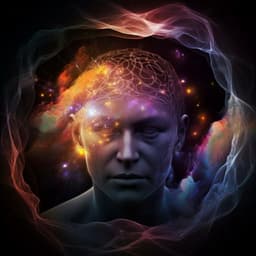
Medicine and Health
The aging human brain exhibits reduced cerebrospinal fluid flow during sleep due to both neural and vascular factors
S. M. Bailes, S. D. Williams, et al.
Aging reduces sleep-dependent cerebrospinal fluid (CSF) flow—linked to impaired frontal EEG delta power, diminished global hemodynamic oscillations, and gray matter atrophy—identifying neural and cerebrovascular mechanisms that may be targets for intervention. This research was conducted by Authors present in <Authors> tag.
~3 min • Beginner • English
Introduction
Aging is a major risk factor for neurodegenerative disorders, and impaired brain waste clearance via cerebrospinal fluid (CSF) circulation has been proposed as a contributing mechanism. Animal studies report aging-related impairments in fluid transport and clearance, but human MRI studies during wakefulness show inconsistent age effects on CSF flow. Sleep is a state of heightened waste clearance, and in young adults, NREM slow waves and vascular oscillations drive large CSF pulsations. Aging is characterized by sleep fragmentation and reduced EEG slow wave activity, which could diminish sleep-dependent CSF flow. Additionally, aging alters cerebrovascular physiology (e.g., vessel stiffening and increased diameter), potentially weakening vasomotor forces that propel CSF. The research question is whether typical, non-pathological human aging is associated with reduced CSF flow during sleep, and which neural and vascular mechanisms contribute. To address this, the study used simultaneous EEG–fMRI measurements of CSF inflow and brain hemodynamics during nighttime sleep in young and older adults, plus daytime causal manipulations (sensory stimulation and breath-hold) to probe neurovascular coupling and cerebrovascular reactivity.
Literature Review
Prior work implicates CSF circulation as central to brain waste clearance and links sleep to heightened clearance (Iliff et al., 2012; Xie et al., 2013; Eide et al., 2021). Aging-related changes in CSF dynamics in humans have been mixed in daytime MRI (Attier-Zmudka et al., 2019; Stoquart-ElSankari et al., 2007; Gideon et al., 1994; Vikner et al., 2024). Sleep reorganizes CSF flow and couples it to delta-band neural activity and hemodynamic oscillations (Fultz et al., 2019). Aging reduces slow wave activity and alters sleep architecture (Landolt et al., 1996; Mander et al., 2013; Varga et al., 2016), and modifies vascular physiology (arterial stiffness, altered diameters) that may affect CSF propulsion (Atkinson, 2008; Li et al., 2018; Juttukonda et al., 2021). Evidence from rodent and human studies shows vascular pulsations critically drive CSF movement (Iliff et al., 2013; Mestre et al., 2018; van Veluw et al., 2020; Wang et al., 2022). Neurovascular coupling may decline with age, though reports vary (D'Esposito et al., 2003; Gauthier et al., 2013; Grinband et al., 2017; Rosengarten et al., 2003; West et al., 2019). Clinical studies have associated reduced CSF flow or coupling with cognitive deficits and AD pathology (Attier-Zmudka et al., 2019; Han et al., 2021; Ferdinando et al., 2023).
Methodology
Participants: Healthy young (18–39 years) and older (60–84/85 years) adults were recruited at two sites (Boston University and MIT) with IRB approval. Exclusions included regular sleep aids, psychiatric/neurological disorders, cognitive impairment, major medical/sleep disorders, substance use, excessive caffeine, or MRI contraindications. Nighttime sleep experiment: 70 completed MRI; after motion/sleep exclusions, n=25 young (mean 24y; 14F) and n=39 older (mean 68y; 20F). Night scans started around midnight; subjects rested with eyes closed and spontaneously slept; sleep was verified via EEG staging and eye tracking. Each subject had 1–3 runs of 25 minutes. Daytime experiments: 103 completed; after exclusions, n=31 young (mean 24.7y; 16F) and n=55 older (mean 69.7y; 34F). Visual task contrast sensitivity controlled; only participants with good/corrected vision and limited prescription strength were included.
Imaging: 3T Siemens Prisma (both sites), 64-channel head/neck coil. Fast fMRI: gradient-echo EPI, TR=0.378 s, TE=31 ms, 2.5 mm isotropic, 40 slices, MB=8, CAIPI FOV/4, flip angle 37°, no in-plane acceleration. Anatomical T1 multi-echo MPRAGE (1 mm isotropic). EEG: 32-channel MR-compatible caps with 4 carbon wire loops, 5000 Hz sampling, synchronized to 10 MHz scanner clock; EOG and EMG channels; respiration belt and PPG recorded. Eye tracking (EyeLink systems) monitored wake/sleep and task compliance.
Tasks: Daytime cerebrovascular reactivity (CVR) breath-hold task with eight 1-minute trials: paced breathing (3 s inhale/exhale ×3), 3 s prepare, 15 s breath-hold, 3 s nasal exhale, 21 s recovery. End-tidal CO2 (PETCO2) via nasal cannula and CapStar-100; CVR maps computed using phys2cvr (lagged GLM). Daytime neurovascular coupling visual task: 12 Hz counterphase flickering checkerboard (ON 16 s; OFF 30–32.5 s) with fixation and button press monitoring; two contrast levels (90% and 45%).
CSF region of interest (ROI): Hand-drawn fourth ventricle masks on single-band reference per run; standardized to bottom four slices. Nighttime used average over mask; daytime used only the bottom slice (selecting the two voxels with largest inflow) to maximize inflow sensitivity during wake.
Preprocessing: fMRI slice-time correction (FSL), motion correction (AFNI 3dvolreg), physiological noise removal using HRAN (harmonic regression with autoregressive noise), registration to anatomy via boundary-based registration (FreeSurfer bbregister). EEG gradient artifact removal via average artifact subtraction (moving average of previous 20 TRs), ballistocardiogram removal using carbon wire loop regression (sliding Hanning window; window 25 s; lag 0.09 ms), re-referenced to average. Sleep scoring followed AASM guidelines (30 s epochs; two trained scorers; Visbrain GUI). Physiological signals aligned via scanner triggers.
Analyses: Nighttime spectral power using multitaper estimation (spectral_connectivity toolbox); fMRI/CSF 5 tapers; EEG 25 tapers; 60 s continuous segments of wake or NREM; exclude segments with average FD > 0.3 mm or max FD > 0.75 mm. Bandpowers: CSF and BOLD 0.01–0.1 Hz; EEG frontal delta 0.5–4 Hz; converted to dB. Group comparisons via Wilcoxon rank-sum; paired analyses via paired t-tests for subjects with both states; linear mixed-effects models for Age×State×Sex interactions. Cross-correlation during NREM: 90 s segments; BOLD/CSF bandpass 0.01–0.1 Hz; frontal EEG delta (Fz or F3) bandpass 0.2–4 Hz; Hilbert amplitude; moving-average smoothing (4 s); correlations computed; permutation bootstrapping (10,000 iterations) to compare groups. CSF peak-locked EEG analysis: CSF converted to percent signal change relative to 15th percentile baseline; CSF 0.01–0.1 Hz filtered; peaks > 5% amplitude identified; frontal EEG delta envelope aligned; group peak amplitude difference tested via permutation (10,000 iterations). Mediation analysis: Serial mediation in lavaan (R): X=age group; M1=frontal delta power (NREM); M2=low-frequency gray matter BOLD power (NREM); Y=low-frequency CSF power (NREM); bootstrapped CIs; p-values under Chi-squared. Daytime visual BOLD responses: V1 and global gray matter masks from FreeSurfer; signals converted to percent change, detrended; trial-averaged in [-5, 46] s window; low-pass <0.1 Hz; motion exclusion (>0.4 mm FD within trial). Statistics: Wilcoxon rank-sum in 8 s bins (Bonferroni-Holm correction). Global gray matter BOLD magnitude: peak window (3–24 s) minus trough (25–35 s); group difference via unpaired t-test. EEG envelope for visual task: average of Pz, O1, O2, Oz; artifact trials removed (>±50 µV); bandpass 11.99–12.01 Hz; Hilbert envelope; Wilcoxon rank-sum across 8 s bins with Holm-Bonferroni. Daytime CSF inflow: trough vs peak windows computed based on hypothesized alternation with BOLD; group differences assessed accordingly. Anatomy: Frontal gray matter volume normalized to intracranial volume; correlations with NREM CSF power assessed; other lobes evaluated in supplement.
Key Findings
• Nighttime sleep CSF dynamics: During NREM sleep, older adults exhibited significantly reduced low-frequency CSF power compared to young adults (frequency band [0, 0.066] Hz, p<0.05, Wilcoxon rank-sum, Holm-Bonferroni; 0.01–0.1 Hz bandpower reduced: sleep p<0.001). Young adults showed significant increases in CSF low-frequency power from wakefulness to NREM (p=0.008); older adults did not show a significant group-level increase (p=0.254). Within-subject paired analysis showed both groups increased CSF power during NREM, but the increase was smaller in older adults (young +4.00 dB vs older +1.65 dB; p=0.02).
• Hemodynamics: Low-frequency global gray matter BOLD power increased from wake to NREM in both groups (p<0.001 each), but was significantly lower in older adults during NREM (psleep=0.002). Mixed-effects modeling showed aging effects were stronger during sleep for both CSF and BOLD power (CSF power ~ Age×State×Sex: pAge:State=0.005; BOLD power ~ Age×State×Sex: pAge:State=0.013).
• CSF–hemodynamic coupling: CSF low-frequency power changes correlated with gray matter BOLD power changes in both groups (young r=0.77; older r=0.72; both p<0.001). Cross-correlation between CSF and negative derivative of gray matter BOLD during NREM showed strong anticorrelation in both groups, slightly weaker in older adults (young max r=0.79 at −1.13 s; older max r=0.68 at −0.76 s; difference=0.11; p=0.008).
• Neural driver (EEG delta): Frontal EEG delta (0.5–4 Hz) power increased from wake to NREM in both groups (pyoung<0.001; polder<0.001) but was significantly lower in older adults, especially during NREM (psleep<0.001; pwake=0.018). Aging effects on frontal delta were stronger during sleep (Age×State×Sex: p=0.049). Change in frontal delta power was strongly associated with change in CSF power in young adults (r=0.73, p<0.001), but weaker and non-significant in older adults (r=0.35, p=0.052); between-group difference p=0.039. Temporal coupling of frontal delta to CSF was weaker in older adults (young max r=0.27 at +8.32 s; older max r=0.14 at +9.23 s; difference=0.13; p<0.001). Peak-locked analyses showed reduced frontal delta amplitude around CSF peaks in older adults (difference 5.87 µV; p<0.001); fewer older adults exhibited identifiable CSF peaks.
• Mediation: Serial mediation (X=age group → M1=frontal delta → M2=gray matter BOLD LF power → Y=CSF LF power) revealed a significant total effect of age on CSF power (c=5.46, p<0.001, 95% CI [2.77, 8.17]) but a non-significant direct effect controlling for mediators (c'=2.20, p=0.107), indicating full mediation by neural and hemodynamic factors. Significant paths: X→M1 (a1=2.85, p<0.001), M1→M2 (b2=0.635, p=0.008), M2→Y (reported as significant), while X→M2 (a2=0.949, p=0.182) was non-significant.
• Daytime CVR and neurovascular coupling: Breath-hold CVR was lower in older adults globally (p=0.018) and in V1 (p=0.025). Visual task evoked similar neural (EEG) responses in both groups (p>0.05 all bins) but significantly reduced V1 BOLD responses in older adults (p<0.01 for t=8.3–33.2 s, Holm-Bonferroni) and reduced global gray matter BOLD magnitude (p=0.036). Evoked CSF inflow was significantly reduced in older adults (t=24.9–33.2 s, p<0.01, Holm-Bonferroni), linking diminished hemodynamic responses to reduced CSF flow despite equal neural drive.
• Structure–function association: Frontal gray matter volume (normalized to intracranial volume) was lower in older adults (p<0.001) and positively correlated with NREM CSF low-frequency power in older adults (r=0.35, p=0.03), but not in young (r=−0.13, p=0.551). Other lobes (occipital, parietal, temporal) showed no significant associations with CSF power.
Discussion
The study demonstrates that aging substantially reduces the large, low-frequency CSF flow waves and global hemodynamic oscillations that occur during NREM sleep. Two mechanisms underlie this decline: diminished neural slow wave (delta-band) activity and altered vascular physiology leading to impaired neurovascular coupling and lower cerebrovascular reactivity. Older adults showed weaker coupling across EEG–BOLD–CSF signals, and daytime experiments that causally drive neurovascular responses revealed that, despite equivalent sensory-evoked neural activity, older adults had reduced BOLD responses and correspondingly reduced CSF inflow, implicating vascular contributions. Furthermore, reduced sleep-dependent CSF flow was associated with frontal gray matter atrophy, consistent with the role of frontal regions in slow wave generation and propagation. These findings address the central hypothesis that typical aging disrupts sleep-dependent CSF dynamics via both neural and vascular pathways, highlighting multi-system deterioration that may impede waste clearance. The results have relevance for understanding how sleep and vascular health interact to influence brain homeostasis across aging, and they suggest that individual variability in sleep quality, neurovascular coupling, and vascular reactivity may yield different mechanistic routes to impaired CSF flow.
Conclusion
Typical human aging is associated with a marked reduction in sleep-dependent CSF flow and global hemodynamic oscillations, driven by both loss of frontal slow wave activity and diminished vascular responsiveness and neurovascular coupling. This multimodal EEG–fMRI study identifies neural and vascular mediators of CSF flow decline and links CSF flow to frontal structural integrity in older adults. Future work should: (1) assess whole-brain CSF dynamics across ventricles and perivascular spaces; (2) directly measure molecular clearance (e.g., tracer studies) to relate macroscopic flow to waste removal; (3) evaluate clinical utility of CSF dynamics for early detection of neurodegeneration; and (4) develop targeted interventions tailored to individual deficits (sleep slow waves vs vascular reactivity/neurovascular coupling).
Limitations
The study measures CSF inflow in the fourth ventricle as a macroscopic, integrated proxy rather than whole-brain CSF flow, limiting spatial specificity to perivascular and interstitial compartments. Clearance of metabolites was not directly measured (no tracer studies), preventing causal links between reduced CSF flow and protein accumulation or cognitive outcomes. Neurovascular coupling and CVR were inferred from BOLD and breath-hold tasks; while robust, these are indirect measures and subject to physiological variability. Sleep imaging in the scanner poses challenges (motion, discomfort) that may reduce sleep depth/continuity and slow wave expression; some runs/channels were excluded due to motion or EEG quality, and not all older subjects exhibited identifiable CSF peaks. Visual task results relied on controlled vision criteria, but residual differences in perception or attention could contribute. The cross-sectional design cannot establish longitudinal trajectories of aging effects. The preprint status implies peer review is pending.
Related Publications
Explore these studies to deepen your understanding of the subject.







